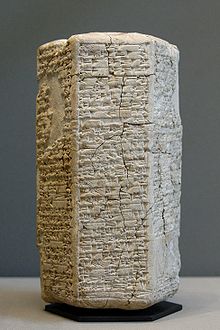- Miscellaneous Babylonian Inscriptions
-
Miscellaneous Babylonian Inscriptions 
Semitic Babylonian contract-tablet inscribed in the reign of HammurabiAuthor(s) George Aaron Barton Country United States Language English Subject(s) Language, Sumerology, Cuneiform studies, Translation Publisher Yale University Press, Oxford University Press Publication date August 1918 Media type print (hardback) Pages 177pp (first edition) ISBN 978-1148598970 OCLC Number 2539495 Dewey Decimal 492/.1 LC Classification PJ3711 .Y34 1983 Miscellaneous Babylonian Inscriptions is a 1918, Sumerian linguistics and mythology book written by George Aaron Barton.[1]
It was first published by Yale University Press in the United States and deals with commentary and translations of twelve cuneiform, Sumerian myths and texts discovered by the University of Pennsylvania Museum of Archaeology and Anthropology excavations at the temple library at Nippur.[2] Many of the texts are extremely archaic, especially the Barton Cylinder, which Samuel Noah Kramer suggested may date as early as 2500 BC.[3] A more modern dating by Joan Goodrick Westenholz has suggested the cylinder dates to around 2400 BC.[4]
Contents
Some of the myths contained in the book are shown below:
Modern title Museum number Barton's title Debate between sheep and grain 14,005 A Creation Myth Barton Cylinder 8,383 The oldest religious text from Babylonia Enlil and Ninlil 9,205 Enlil and Ninlil Self-praise of Shulgi (Shulgi D) 11,065 A hymn to Dungi Old Babylonian oracle 8,322 An Old Babylonian oracle Kesh temple hymn 8,384 Fragment of the so-called "Liturgy to Nintud" Debate between Winter and Summer 8,310 Hymn to Ibbi-Sin Hymn to Enlil 8,317 An excerpt from an exorcism Lament for Ur 19,751, 2,204, 2,270 & 2,302 A prayer for the city of Ur References
- ^ George Aaron Barton (1918). Miscellaneous Babylonian Inscriptions. Yale University Press. http://books.google.com/books?id=nn5hAAAAMAAJ. Retrieved 23 May 2011.
- ^ C. Wade Meade (1974). Road to Babylon: Development of U.S. Assyriology. Brill Archive. pp. 87–. ISBN 9789004038585. http://books.google.com/books?id=iuAUAAAAIAAJ&pg=PA87. Retrieved 5 June 2011.
- ^ Samuel Noah Kramer (1961). Sumerian Mythology: a study of spiritual and literary achievement in the third millennium B.C.. Forgotten Books. pp. 28 & 148. ISBN 9781605060491. http://books.google.com/books?id=t16tDOHZLLEC&pg=PA148. Retrieved 5 June 2011.
- ^ Miguel Ángel Borrás; Centre de Cultura Contemporània de Barcelona (2000). La fundación de la ciudad: mitos y ritos en el mundo antiguo. Edicions UPC. pp. 46–. ISBN 9788483013878. http://books.google.com/books?id=3yPVFGPr0aoC&pg=PA46. Retrieved 5 June 2011.
External links
Categories:- 1918 books
- American non-fiction books
- Linguistics books
- Hymnals
- Collections of fairy tales
- Essay collections
- Works about the Great Basin
- Oral history books
- Public domain books
- Sumer
- Archaeology books
- Sumerian texts
Wikimedia Foundation. 2010.

